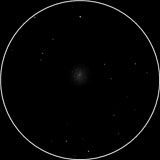
| MESSIER 14 |
|---|
RA: |
17h 37m 36s |
|
DEC: |
-03° 15' 00'' |
|
Type: |
Globular cluster |
|
NGC: |
6402 |
|
Magnitude: |
7.60 |
|
Surface brightness : |
12.5 |
|
Apparent dimensions : |
11'x11' |
|
Distance: |
30,300 ly |
|
Messier 14 (also known as M14 or NGC 6402) is a globular cluster in the constellation Ophiuchus. It was discovered by Charles Messier in 1764. At a distance of about 30,000 light-years, M14 contains several 100,000 stars. At a brightness of magnitude 7.6 it can be easily observed with binoculars and medium sized telescopes begin to show some hint of the individual stars of which the brightest is of magnitude +14. Slightly over 3° southwest of M14 lies the faint globular cluster NGC 6366.
|
||
VEDRAN VRHOVAC© 2006.-2007. |
